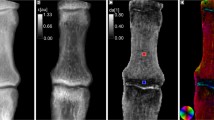Abstract
X-ray microradiography is a well established technique for the study of biological structures in which the projected absorption is measured, usually with photographic film or resist. If scanning X-ray microradiography with a 15-μm beam, 2-D scanning, and photon counting is used, more accurate results can be obtained and real-time experiments undertaken. Addition of a rotation axis allows computerized axial tomography to be done at a resolution of 15 μm. This technique overcomes the inherent difficulty of microradiography that all detail perpendicular to the plane of the specimen is superimposed. This method has been applied to the study of the 3-D mineral distribution in a 0.8×0.8 mm column of human cortical bone with a laboratory X-ray source. Calculation of the wavelength dependence of the linear absorption coefficient for liver and bone shows that, for a choice of wavelength in the range of 3–0.4 Å (4–30 keV), the specimen thickness can be from 100μm–2 cm and 10 μm–3 mm, respectively.
Synchrotron X-radiation has the potential for better resolution because of the higher intensity, which allows the use of a narrower beam. There is also the possibility of determining individual element 3-D distributions from measurements on either side of the absorption edges because of the continuous nature of the spectrum and also the possibility of doing this from X-ray fluorescence measurements. To investigate these possibilities, a tomographic apparatus has been built based on the availability of accurately ground, tungsten carbide balls. Metrological assessment shows that the specimen remains within <1 μm of the required position during translation and rotation. Preliminary X-ray tomographic studies with a 4-μm diameter beam have been started at the Daresbury laboratory synchrotron source.
Similar content being viewed by others
References
R. V. Ely (ed.)Microfocal Radiography, Academic, London, 1980.
E. Spiller and R. Feder, inX-ray Optics, Applications to Solids H.-J. Queisser, ed., Springer-Verlag, Berlin, 1977, pp. 35–92.
R. S. Barrows and R. N. Wolfe,Photgr. Sci. Eng. 15, 472 (1971).
P. Horowitz and J. A. Howell,Science 178, 608 (1972).
P. Horowitz,Ann. NY Acad. Sci. 306, 203 (1978).
G. Schmahl and D. Rudolph (eds),X-ray Microscopy, Springer-Verlag, Berlin, 1984.
J. Kirz and H. Rarback,Rev. Sci. Instrum. 56, 1 (1985).
P. Anderson and J. C. Elliott,Caries Res. 19, 403 (1985).
G. N. Hounsfield,Br. J. Radiol. 46, 1016 (1973).
P. Reimiers, W. B. Gilboy, and J. Goebbels,NDT Int. 17, 197 (1984).
L. Grodzins,Nucl. Instrum. Meth. 206, 541 (1983).
L. Grodzins,Nucl. Instrum. Meth. 206, 547 (1983).
J. C. Elliott and S. D. Dover,Metab. Bone Dis. Rel. Res. 5, 219 (1984).
J. C. Elliott and S. D. Dover,J. Microscop. 138, 329 (1985).
D. K. Bowen, J. C. Elliott, S. R. Stock, and S. D. Dover,SPIE 691, 94 (1986).
Author information
Authors and Affiliations
Rights and permissions
About this article
Cite this article
Elliott, J.C., Bowen, D.K., Dover, S.D. et al. X-ray microtomography of biological tissues using laboratory and synchrotron sources. Biol Trace Elem Res 13, 219–227 (1987). https://doi.org/10.1007/BF02796634
Issue Date:
DOI: https://doi.org/10.1007/BF02796634




